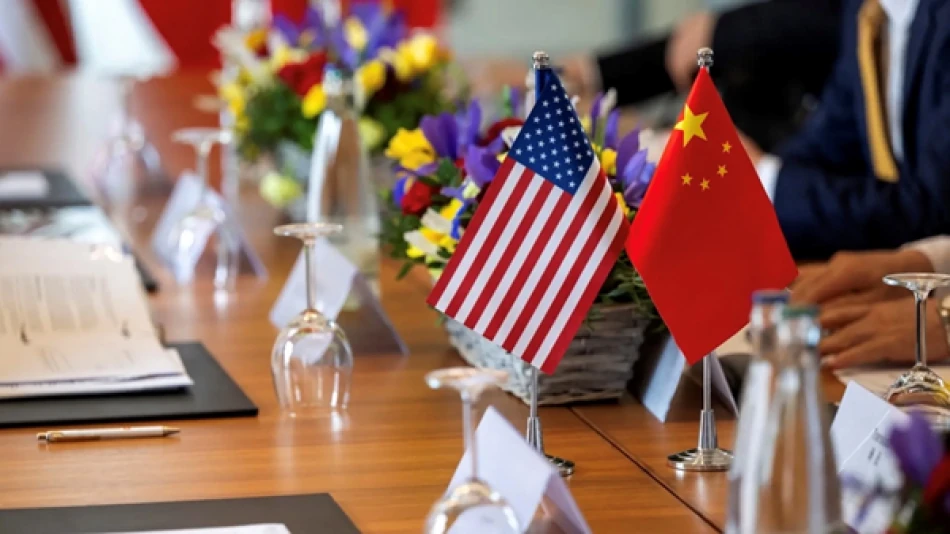
US Pushes for Extended China Trade Talks Amid High-Stakes Negotiations
US Treasury Chief Signals Potential Tariff Extension With China as Trade War Escalates
US Treasury Secretary Scott Bessent indicated Tuesday that Washington is open to extending the current 90-day tariff reduction window with China beyond its August 12 deadline, offering a potential pause in the escalating trade conflict that has seen punitive duties surge to 145% on American imports from China. The move suggests both economic superpowers may be seeking breathing room as retaliatory measures threaten to disrupt global supply chains and market stability.
Stockholm Talks Could Provide Trade War Reprieve
Speaking to Fox Business, Bessent revealed he will meet with Chinese counterparts in Stockholm on Monday and Tuesday to discuss what he termed a potential extension. "I'll be working on what could be an extension, and then I think trade with China is in very good shape," the Treasury Secretary said, signaling cautious optimism about bilateral negotiations.
The current 90-day negotiation window was designed to create space for dialogue between the world's two largest economies, but with the August 12 deadline looming, both sides appear to recognize that meaningful progress requires more time.
Tariff Spiral Reaches Critical Mass
The stakes for these discussions have never been higher. President Donald Trump's administration has systematically escalated punitive tariffs on Chinese imports to an unprecedented 145%, representing one of the most aggressive trade policy moves in modern US history. This figure dwarfs the tariff levels seen during previous trade disputes and signals a fundamental shift in how Washington views economic competition with Beijing.
China has responded with equal force, imposing 125% counter-tariffs on American goods while leveraging its control over rare earth metals—critical components for everything from smartphones to military equipment—by restricting exports to the United States.
Market and Investor Implications
For global markets, any extension represents a double-edged sword. While it may provide temporary relief from escalating trade tensions, it also prolongs uncertainty that has already rattled supply chains and investment planning across multiple sectors.
Manufacturing and technology companies with significant China exposure have been particularly vulnerable, as the tariff increases directly impact profit margins and sourcing strategies. An extension could offer these firms additional time to diversify supply chains or negotiate alternative arrangements.
Currency markets are likely to respond positively to any signs of de-escalation, with both the yuan and dollar potentially stabilizing if negotiations show progress. However, the rare earth metals restrictions add a strategic dimension that goes beyond traditional trade disputes, affecting sectors from renewable energy to defense manufacturing.
Historical Context and Global Precedent
The current US-China trade standoff echoes but exceeds the intensity of previous major trade conflicts. Unlike the more targeted disputes of the 1980s and 1990s, this confrontation spans technology transfer, intellectual property, and strategic industries that both nations consider essential to their economic futures.
The 145% tariff level represents a significant escalation from typical trade dispute measures, which historically ranged from 10-30%. This suggests the current conflict transcends normal commercial disagreements and reflects deeper concerns about technological competition and economic security.
Strategic Calculations Behind the Extension
Bessent's willingness to discuss an extension likely reflects several practical considerations. First, the economic impact of sustained 145% tariffs would inevitably affect American consumers and businesses, creating domestic political pressure. Second, China's rare earth restrictions pose genuine supply chain risks for critical US industries.
From China's perspective, an extension offers time to explore alternative markets and reduce dependence on US trade while maintaining leverage through rare earth controls. Beijing's 125% counter-tariffs demonstrate its willingness to absorb economic costs to maintain negotiating position.
The outcome of the Stockholm meetings will signal whether both nations are prepared to step back from a trade conflict that increasingly resembles economic warfare rather than traditional commercial negotiation.
Most Viewed News

 Layla Al Mansoori
Layla Al Mansoori






